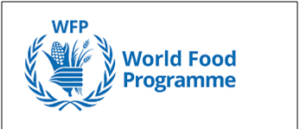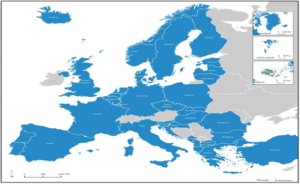श्रेणी: विविध
प्रसंग:
- संयुक्त राष्ट्र एजेंसी ने चेतावनी दी है कि सोमालिया में लाखों लोग भुखमरी की समस्या से जूझ रहे हैं, क्योंकि दानदाताओं की सहायता में भारी कटौती के कारण विश्व खाद्य कार्यक्रम के लिए वित्तीय घाटा गंभीर हो गया है।
विश्व खाद्य कार्यक्रम के बारे में:

- स्थापना: यह विश्व की सबसे बड़ी मानवीय एजेंसी है और इसकी स्थापना 1961 में हुई थी।
- संयुक्त राष्ट्र से संबद्ध: यह संयुक्त राष्ट्र की एक शाखा है जो भूखमरी उन्मूलन से संबंधित है और विश्व में खाद्य सुरक्षा को बढ़ावा देती है।
- एसडीजी 2: संगठन का कार्य सतत विकास लक्ष्य 2 द्वारा निर्देशित है, जिसका उद्देश्य 2030 तक भुखमरी को समाप्त करना, खाद्य सुरक्षा और बेहतर पोषण प्राप्त करना और टिकाऊ कृषि को बढ़ावा देना है।
- विस्तार: यह 120 से अधिक देशों में कार्यरत है, आपात स्थितियों के दौरान खाद्य सहायता प्रदान करता है तथा पोषण बढ़ाने और लचीलापन उत्पन्न करने के लिए समुदायों के साथ काम करता है।
- वित्तपोषण: विश्व खाद्य कार्यक्रम (WFP) के पास धन का कोई स्वतंत्र स्रोत नहीं है, यह पूरी तरह से स्वैच्छिक दान से वित्त पोषित होता है। इसके प्रमुख दानदाता सरकारें हैं, लेकिन संगठन को निजी क्षेत्र और व्यक्तियों से भी दान मिलता है।
- नोबेल पुरस्कार: डब्ल्यूएफपी को भूख से निपटने, संघर्ष प्रभावित क्षेत्रों में शांति के लिए बेहतर स्थिति बनाने और युद्ध और संघर्ष के हथियार के रूप में भूख के उपयोग को रोकने के प्रयासों के लिए 2020 के शांति के नोबेल पुरस्कार से सम्मानित किया गया है।
- डब्ल्यूएफपी द्वारा रिपोर्ट: डब्ल्यूएफपी द्वारा जारी रिपोर्ट खाद्य संकट पर वैश्विक रिपोर्ट है जो विश्व में तीव्र भूखमरी के पैमाने का वर्णन करती है।
- मुख्यालय: इसका मुख्यालय रोम, इटली में स्थित है।
स्रोत:
(MAINS Focus)
भारत में स्वच्छ ऊर्जा वृद्धि और जलवायु वित्त के विस्तार की आवश्यकता (India’s Clean Energy Rise and the Need for Expanding Climate Finance)
(जीएस पेपर 3: संरक्षण, पर्यावरण प्रदूषण और क्षरण, पर्यावरण प्रभाव आकलन)
संदर्भ (परिचय)
रिकॉर्ड सौर ऊर्जा वृद्धि और नवीकरणीय ऊर्जा में वैश्विक नेतृत्व के साथ, भारत का तेज़ी से हो रहा स्वच्छ ऊर्जा विस्तार, एक गंभीर वित्तीय चुनौती का सामना कर रहा है। मज़बूत प्रगति के बावजूद, 2030 तक जलवायु लक्ष्यों को प्राप्त करने के लिए जलवायु वित्त और नवीन वित्तपोषण मॉडलों में नाटकीय वृद्धि की आवश्यकता है।
भारत की स्वच्छ ऊर्जा गति
- तीव्र विकास: भारत ने 2024 में 24.5 गीगावाट सौर क्षमता जोड़ा, जो कि विश्व स्तर पर तीसरे सबसे बड़े योगदानकर्ता चीन और अमेरिका के बाद है।
- रोजगार और सकल घरेलू उत्पाद: नवीकरणीय क्षेत्र में दस लाख से अधिक श्रमिक कार्यरत हैं, जो सकल घरेलू उत्पाद की वृद्धि में 5% का योगदान करते हैं; ऑफ-ग्रिड सौर ऊर्जा अकेले 80,000 नौकरियों का समर्थन करती है।
- वैश्विक मान्यता: संयुक्त राष्ट्र महासचिव की 2025 जलवायु रिपोर्ट में भारत को सौर और पवन ऊर्जा के क्षेत्र में अग्रणी माना गया है।
- संस्थागत नेतृत्व: इस तरह की पहल अंतर्राष्ट्रीय सौर गठबंधन (आईएसए) और सॉवरेन ग्रीन बांड में भारत की सक्रिय वैश्विक और घरेलू भूमिका को प्रदर्शित करते हैं।
- आर्थिक वादा: IRENA के अनुसार, 1.5 डिग्री सेल्सियस-संरेखित मार्ग 2050 तक 2.8% वार्षिक जीडीपी वृद्धि प्राप्त कर सकता है, जो जी-20 औसत को पार कर जाएगा।
महत्वपूर्ण अंतराल - जलवायु वित्त घाटा
- वित्तपोषण की आवश्यकता: भारत को अपने एनडीसी और 1.5°C लक्ष्यों को पूरा करने के लिए 2030 तक 1.5-2.5 ट्रिलियन डॉलर के जलवायु वित्त की आवश्यकता है।
- वर्तमान प्रवाह: 2021 से जीएसएस+ ऋण जारी करने में 186% की वृद्धि के बावजूद, 55.9 बिलियन डॉलर का कुल संरेखित जारीकरण अपर्याप्त है।
- निजी क्षेत्र का प्रभुत्व: 84% ग्रीन बॉन्ड बड़े कॉरपोरेट्स से आते हैं; एमएसएमई, कृषि-तकनीक नवप्रवर्तक और स्थानीय बुनियादी ढांचा डेवलपर्स को वित्त पोषण संबंधी बाधाओं का सामना करना पड़ता है।
- सीमित रियायती वित्त: जोखिम कम करने वाले उपकरण और मिश्रित वित्त तंत्र का कम उपयोग किया जाता है।
- क्षेत्रीय असमानताएँ: शासन और वितरण जोखिमों के कारण टियर-II और III शहरों में निवेशकों का विश्वास कम है।
सुधार और रणनीतिक बदलाव
- मिश्रित वित्त विस्तार: आंशिक गारंटी, अधीनस्थ ऋण और प्रदर्शन गारंटी का उपयोग जोखिम-वापसी अनुपात में सुधार कर सकता है और निजी निवेशकों को आकर्षित कर सकता है।
- सार्वजनिक वित्त उत्तोलन: सरकारें निजी पूंजी जुटाने के लिए ग्रीन बजट टैगिंग, राजकोषीय प्रोत्साहन और जोखिम कम करने के उपायों को एकीकृत कर सकती हैं।
- संस्थागत पूंजी जुटाना: पेंशन फंड और ईपीएफओ और एलआईसी जैसी बीमा कंपनियों को ईएसजी नियामक सुधारों के माध्यम से जलवायु-संरेखित परिसंपत्तियों के लिए पोर्टफोलियो आवंटित करना चाहिए।
- कार्बन बाज़ार: कार्बन क्रेडिट ट्रेडिंग स्कीम (सीसीटीएस) पारदर्शी, न्यायसंगत और विनियमित होने पर एक प्रमुख वित्त स्रोत बन सकती है।
- प्रौद्योगिकी एकीकरण: जोखिम विश्लेषण के लिए एआई और जलवायु वित्त ट्रैकिंग के लिए ब्लॉकचेन को अपनाने से जवाबदेही और नवाचार को बढ़ाया जा सकता है।
आलोचनाएँ और चुनौतियाँ
- अपर्याप्त अनुकूलन वित्त: वर्तमान प्रवाह शमन पर केंद्रित है; अनुकूलन और हानि-और-क्षति वित्तपोषण अल्प वित्त पोषित बने हुए हैं।
- विनियामक अस्पष्टता: एकीकृत ईएसजी निवेश मानदंडों का अभाव संस्थागत निवेशकों को रोकता है।
- सीमित घरेलू उपकरण: भारत का हरित बांड बाजार अभी भी प्रकटीकरण और परियोजना प्रमाणन के वैश्विक मानकों से पीछे है।
- बाह्य पूंजी पर निर्भरता: अंतर्राष्ट्रीय ऋणों पर अत्यधिक निर्भरता से ऋण स्थिरता पर चिंताएं उत्पन्न होती हैं।
- समानता और पहुंच संबंधी मुद्दे: छोटे उद्यमों को हरित निधि तक पहुंचने में प्रक्रियागत बाधाओं और पूंजी की उच्च लागत का सामना करना पड़ता है।
आगे की राह - जलवायु वित्त क्रांति की ओर
-
- सतत परियोजनाओं की एक एकीकृत रजिस्ट्री और एकीकृत प्रमाणन मानकों के साथ एक राष्ट्रीय हरित वित्त ढाँचा बनाएँ।
- पारदर्शिता के लिए सततता-संबंधी बॉन्ड पर सेबी की निगरानी को मज़बूत करें।
- क्षेत्रीय जलवायु कोष छोटे शहरों और ग्रामीण क्षेत्रों में उप-राष्ट्रीय परियोजनाओं का वित्तपोषण कर सकते हैं।
- सार्वजनिक-निजी जलवायु कोष, हरित जलवायु कोष (जीसीएफ) मॉडल के समान, जोखिम को एक साथ ला सकते हैं और पैमाने को बढ़ा सकते हैं।
- वैश्विक नेतृत्व की भूमिका: आईएसए के संस्थापक के रूप में, भारत निष्पक्ष वित्त प्रवाह की वकालत करते हुए एक वैश्विक दक्षिण जलवायु वित्त गठबंधन के लिए प्रयास कर सकता है।
निष्कर्ष
भारत की स्वच्छ ऊर्जा में वृद्धि वैश्विक आशा जगाती है, लेकिन समतामूलक और मापनीय जलवायु वित्त के बिना, यह परिवर्तन ठप्प पड़ने का जोखिम है। जलवायु वित्त नवाचार में अग्रणी भूमिका निभाकर, भारत आर्थिक विकास को वैश्विक प्रबंधन और सामाजिक समावेशन के साथ जोड़ सकता है।
मुख्य परीक्षा अभ्यास प्रश्न:
पर्याप्त एवं न्यायसंगत जलवायु वित्त जुटाने में प्रमुख चुनौतियां क्या हैं, तथा भारत अपने वित्तपोषण ढांचे को कैसे मजबूत कर सकता है ? (250 शब्द, 15 अंक)



